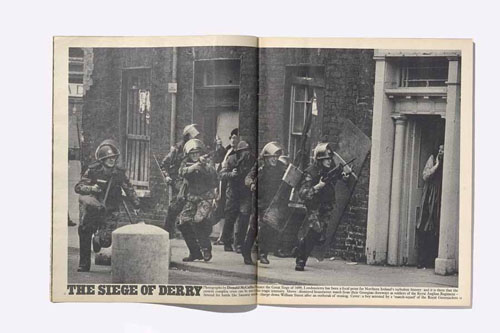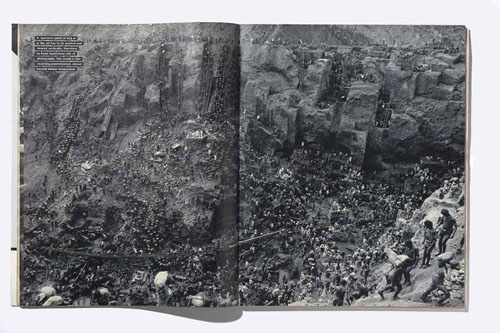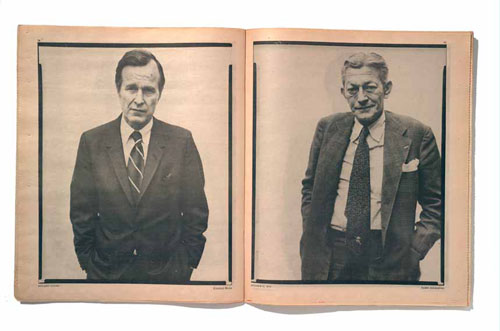|
Things
As They Are -- Photojournalism in Context Since 1955
By
Mary Panzer, with an afterword by Christian Caujolle
World
Press Photo, Amsterdam, and Chris Boot Ltd., London, 2005
Reviewed
by Francis Hodgson
World
Press Photo is a charity which exists to promote photojournalism,
principally by an annual competition and touring exhibition.
At any time in the last thirty years there have been good
reasons to fear for the future of photojournalism.
First television, then the internet threatened the magazines
around which the trade had centred. The digital revolution,
first in image distribution, then in image capture, presented
(and still presents) another huge worry. This book
ends with a glance at the way that camera-phone pictures
by amateurs make the front pages in cases like the Indian
Ocean tsunami. (The specifically British example would
be the underground bombings of July last year.) Professional
photographers get around the world with astonishing speed
but every western citizen now carries a camera in his pocket
and knows enough about the media to make its pictures available
for publication within an e-mail or two. It is easy to see
how the professionals might tremble for their livelihood.
There
are other worries. Photojournalism used to be the
flower of photography, and often the flower of journalism,
too. Editors have less money for big newsy photographic
projects, now, and photographers have to look for funding
elsewhere. It is in the art world that photography
is the driving force, and the medium of choice. In
journalism it is now just one ingredient of the digital
soup. Further, the conditions of distribution have been
so radically altered by the growth and aggregation of the
picture libraries that the independence of the photographers
and of the small agencies through which they used to work
is seriously in doubt. A note of slightly nervous nostalgia
in this book is understandable. It should so obviously
have been called Things As They Were, for the industry will
never be the same again. Yet it is not too late to understand
the practical and ethical issues which photojournalism has
already confronted. It’s not going to disappear,
even if the conditions in which it operates are changing
faster than anybody might have predicted.
|
|

|
Don
McCullin ‘Siege of Derry - dismayed housewives watch
as soldiers of the Royal Anglian Regiment charge down William
Street after an outbreak of stoning’, published in
the Sunday Times Magazine (UK), 1971
Photograph
© Don McCullin |
|
|
The
specificity of this book is that the pictures and the stories
in which they were grouped are presented as they were originally
seen, with whole magazine pages including text and headlines
overlaid or alongside. This capitalizes, no doubt perfectly
deliberately, on the present mania for “design”.
By presenting pretty layouts (and many are more than that,
good examples of the perpetually engrossing waltz between
space and pictures and text) the book takes some of the
heat out of the pictures. But at what point does a
well designed and copiously illustrated book like this become
“coffee-table”? And if even the suggestion of
triviality or superficiality is possible, what does that
make of the subjects of the photographs? In this book, as
always, the relations between photography and reality are
uncomfortable, difficult. It is hard to escape that old
familiar feeling that great suffering, great injustice,
great squalor and anger and pain have been a little too
easy to render on coated paper.
Reproducing
original layouts entire is awkward. It implies the
restoration of the original teams: writers, graphic designers,
editors and picture editors, are all as important in a full
layout as the photographers. The pictures are put forward
here as elements for editors and designers to use, which
in the real world they certainly were. But no proper credits
are consistently given to the designers and the reproduced
text is normally too small to read. The book thus
silently perpetuates the romantic concentration on the photojournalist
as an individual perhaps more free in his movements than
he has ever really been.
|
|

|
Sebastião
Salgado ‘Serra Pelada – A barranco
(plot) of 6sq m in the pit has to be worked and cleared
vertically, therefore by hand. The result is this swarming
pandemonium, almost beyond human imagination’, published
in the Sunday Times Magazine (UK), 1987
Photographs
© Sebastião Salgado / Amazonas Images
/ nbpictures |
|
But
of course that is one strand of the story. However
much one looks at photojournalism as a sub-branch of the
modern media industries or modern visual culture, it is
hard to escape the extraordinary people at its heart.
Alfred Eisenstaedt, asked in the BBC series The Master Photographers
how he felt photographing Hitler, answered for the whole
profession: “When I have a camera in my hand, I know
no fear.”
This
is not specially or even mainly a book of war photographs.
It has its share of them, however, and puts them in a thought-provoking
context. The editors are sensitive enough to deal
well with possible charges like Western centredness, or
of magazines being far from neutral arenas. They are
clear in what they are concentrating upon: connected series
of pictures not individual images, and images published
mainly in magazines. Here is Don McCullin’s
report from Derry for the Sunday Times in 1971, brilliant
picture after brilliant picture. A squad of howling
soldiers charges past two doorways in which civilian ladies
take the only cover they can find. A pale bollard
in the left half balances the pale doorway on the right.
The movement is so wholly from left to right that even the
cowering ladies lean that way, as though blown over by the
wind-wake of the rushing soldiers. McCullin saw black soldiers
fighting white civilians, a shocking reversal of the colonial
norm. And we would all get used, in time, to his portrayal
of conflict as white against white. It takes an effort,
even in front of the magazine spreads reproduced, to remember
just how shocking this was. Photography would never be able
to analyse, for example, the failure of local government
in Northern Ireland in great detail. But nobody could see
these pictures in London and think that there was just a
little civil disorder going on over the sea.
The
focus upon magazines may have been a mistake. It looks better
in the early years of this overview than it does at the
end. So many photographers now regard the book as
the proper complete expression of their work, and magazine
publication only as a necessary intermediary stage, that
the story is somewhat falsified by concentrating on the
old-fashioned model of publishing. By what standard, for
example, can one consider Robert Frank’s fundamental
book, The Americans (published right at the beginning
of the period covered here, in 1958) not to be photojournalism?
|
|

|
Richard
Avedon ‘The Family – George Bush and James Angleton’,
published in Rolling Stone (USA), 1976
Photographs
© Richard Avedon |
|
On the other hand, many might be surpised by the inclusion
of Richard Avedon’s 1976 issue of Rolling Stone with
its dozens of apparently plain straight portraits on a white
ground of the American political establishment. My
own view is that this broader, more inclusive view is important
and interesting: too many views of photojournalism shy away
from the plain fact that looking with burning critical interest
at the world need not necessarily mean looking only at gore.
Here we have also Bruce Weber’s astonishing series
of the US Olympic team before the Los Angeles Games of 1984.
The hero-worshipping point of view is quite openly derived
from Leni Riefenstahl’s photography of the Olympians
of the Nazi games in 1936. The camera is lower than
the athletes, who are seen in the kind of luscious mid-tones
deliberately conceived to render muscle. Yet Weber managed
to query his own make-believe by the simplest means of all.
The tarpaulin backdrop of his mobile studio is in almost
every shot. It is partly a grubby theatre curtain, but it
is also a quote from the crude illusions of nineteenth century
portrait studios. The camera may always tell the truth,
these pictures say, but whose truth and which truth is not
always so plain. That’s a salutary thought to bear
in mind perhaps particularly in front of war photography.
This
book, perhaps inevitably, makes too many arbitrary judgments
of what’s in or out to count as a critical history,
yet it is plainly an honourable and serious book with ambitions
above the coffee-table. That it struggles to situate
itself naturally may be its undoing. Both journalism and
photography used to be mainly learnt in the doing.
Navigating the precarious reefs of technique, of law, of
ethics and opportunity and marketing was done by the seat
of the pants. But each discipline now has a large
and serious academic and semi-academic hinterland.
It is asking for trouble to step back from the red-hot immediacy
of photojournalism in process without fully moving to a
cool concentration of dispassionate analysis. In the
end, this is an exhilarating tale of photographic knights-errant
on quest, and a good-looking collection of some hundred
and twenty picture stories, but it skirts more issues than
it covers in depth.
Francis
Hodgson, who is based in London, writes regularly on photography
for the Financial Times and other publications.
Things
As They Are - Photojournalism in Context Since 1955
by Mary Panzer is published by Chris Boot in association
with World Press Photo, price £45.00
Book
available with 30% discount on www.chrisboot.com
|
|
|

